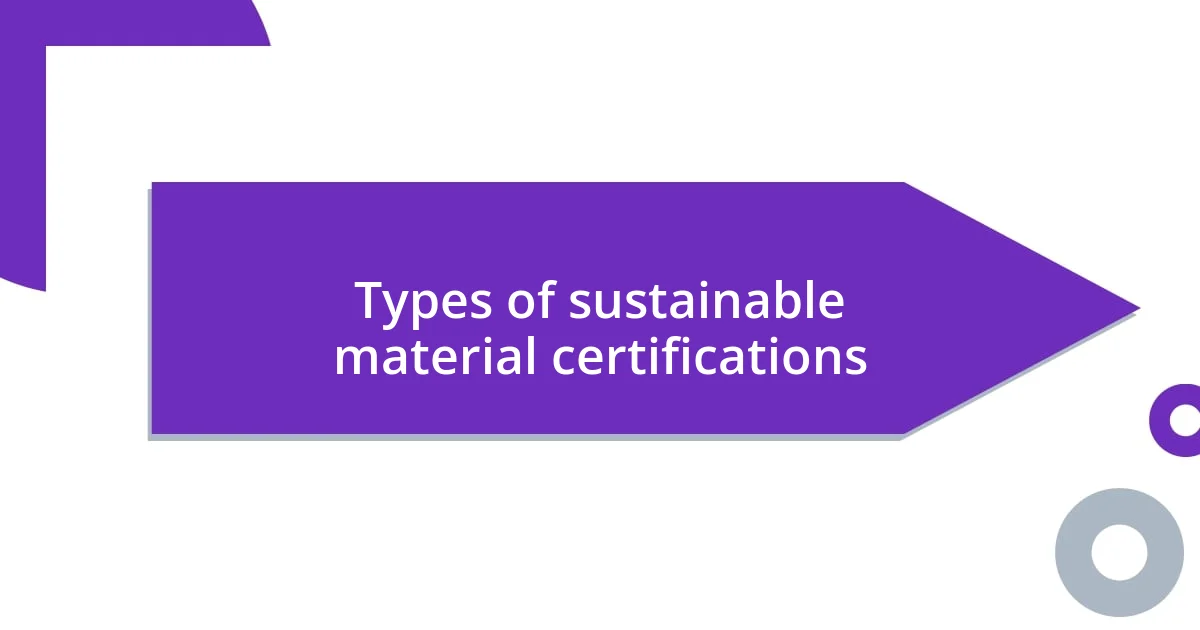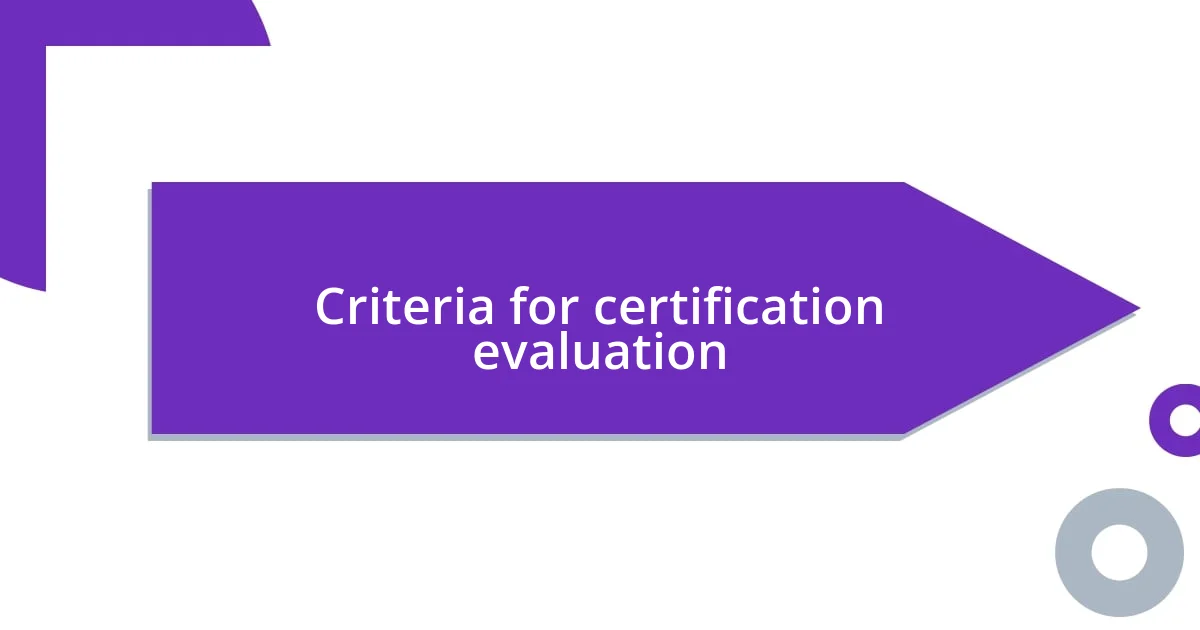Key takeaways:
- Sustainable material certifications vary in credibility; some are rigorously upheld while others may serve mainly as marketing tools.
- Certifications not only support ethical consumer choices but can also inspire brands to improve their sustainability practices and positively impact their communities.
- Future trends in sustainable certifications are likely to emphasize inclusivity, technological integration for transparency, and a broader focus on environmental and social impacts.

Understanding sustainable material certifications
Sustainable material certifications serve as a guiding light in the often murky waters of eco-friendly choices. I remember the overwhelming feeling I had when I first encountered a myriad of labels while shopping for home goods. It struck me then: how do consumers really know which certifications matter? Knowing what each certification represents helps demystify them and empowers consumers to make informed decisions.
As I delved deeper into the subject, I realized that the credibility of these certifications can vary widely. Some are backed by rigorous standards, while others feel more like a marketing ploy. For instance, when I learned about the Forest Stewardship Council (FSC) label, which guarantees that wood products come from responsibly managed forests, it resonated with my values. It reminded me of the time I hiked through a lush forest and felt a renewed appreciation for sustainable practices.
Moreover, the process of obtaining certification itself is no walk in the park. I was surprised to discover how much companies invest in achieving and maintaining these certifications; it speaks volumes about their commitment to sustainability. Have you ever considered how a simple label could represent the labor of many passionate individuals working to protect our planet? This realization not only increased my respect for certified products but also inspired me to support those companies that truly prioritize sustainability.

Importance of certifications in sustainability
Recognizing the importance of certifications in sustainability is paramount for both consumers and producers. I often find myself reflecting on my own purchasing decisions, realizing how much trust I place in these labels. It gives me a sense of comfort, knowing that when I buy certified products, I’m supporting practices that minimize environmental impact and promote ethical sourcing. This isn’t just about buying a product; it’s a commitment to a larger movement.
In my experience, certifications can often serve as a bridge between consumers and responsible brands. For example, I remember my first encounter with the Organic certification while browsing the produce aisle. Suddenly, that simple green label symbolized my choice for healthier food, not just for me, but for the planet. It was a moment of clarity that spotlighted how powerful certification can be in driving conscious consumerism.
Additionally, the influence of certifications extends beyond individual choices; they can inspire entire industries to adopt better practices. I vividly recall attending a sustainability conference where representatives from various companies shared their journeys toward certification. Their stories were filled with struggles and triumphs, but undeniably, there was a common thread: these certifications were catalysts for positive change in their operations. This motivated me to support brands that are not only certified but actively engaged in evolving their sustainability practices.
| Certification Type | Key Features |
|---|---|
| FSC (Forest Stewardship Council) | Ensures responsible sourcing of wood products from well-managed forests. |
| LEED (Leadership in Energy and Environmental Design) | Promotes sustainable building practices through design, construction, and operation. |
| Organic | Guarantees that agricultural products are grown without synthetic pesticides or fertilizers. |

Types of sustainable material certifications
Sustainable material certifications come in various types, each highlighting different aspects of eco-friendliness and ethical practices. One type that resonates with me is the Global Organic Textile Standard (GOTS). This certification not only ensures that textiles are made from organic fibers but also guarantees sustainable processing methods. I remember the first time I felt a GOTS-certified cotton shirt. It felt softer and more luxurious, and knowing the positive impact of its production made me appreciate it even more.
Here’s a brief overview of some significant sustainable material certifications:
- FSC (Forest Stewardship Council): Assures responsible sourcing of wood from sustainably managed forests.
- LEED (Leadership in Energy and Environmental Design): Focuses on sustainable building practices throughout design, construction, and operation.
- GOTS (Global Organic Textile Standard): Certifies organic textiles and ensures environmentally-friendly processing.
- Fair Trade: Supports fair wages and working conditions for producers while promoting sustainable practices.
- Energy Star: Identifies energy-efficient products and buildings, encouraging reduced energy consumption.
Understanding these certifications allows us to make choices aligned with our values, and it reminds me that every product holds a story of its journey toward sustainability.

Criteria for certification evaluation
When evaluating certification criteria, key factors like transparency and adherence to established standards are essential. I remember my first deep dive into certification methods—it was eye-opening to see how varied the criteria could be. I often wonder how many consumers really know what goes into that certification label. It’s not just a stamp; it’s a rigorous process that holds brands accountable and ensures that they truly walk the talk regarding sustainability.
Another critical aspect of evaluation is the ongoing compliance requirements. Certifications are not a one-time deal; they often involve regular audits and assessments to maintain their status. Reflecting on my experiences, I appreciate brands that prioritize this continuous improvement. They show commitment beyond the first certification, which builds a sense of trust and encourages me to invest in their products repeatedly.
Lastly, community and environmental impact are vital evaluation criteria. I once attended a workshop where a local brand shared their journey towards certification and highlighted how it transformed their community. Seeing their firsthand impact made me realize that certifications are not just about products; they’re about the positive ripple effects they create. It makes me excited about supporting brands that genuinely make a difference.

Benefits of using certified materials
Using certified materials comes with a plethora of benefits that I find truly impactful. For instance, certifications often ensure that the materials are sourced sustainably, which gives me peace of mind. I recall purchasing a piece of furniture labeled with the FSC certification. Not only did it elevate my home decor, but knowing that it came from responsibly managed forests made me feel like I was contributing to a healthier planet.
Additionally, opting for certified materials often translates to higher quality products. I once invested in a pair of shoes certified by Fair Trade, and the difference was unmistakable. They not only provided exceptional comfort but also had a storytelling aspect tied to their production — I appreciated every step in them. Isn’t it comforting to know that your purchase has a direct, positive impact on the lives of workers and the environment?
Moreover, using certified materials can foster a sense of community. I remember attending a local fair where vendors showcased their certified products. Each label told a unique story that resonated with my values. This connection invigorated my support for small businesses and sustainable practices. How often do we get the chance to make a choice that aligns with our ethics while also enjoying great quality? It’s a win-win situation that I encourage everyone to explore.

Challenges in obtaining certifications
Obtaining sustainability certifications can often feel like navigating a maze—every turn presents its own set of challenges. I recall a moment when a small artisan brand I admired struggled to meet the requirements for organic certification. Their story reminded me that while their dedication was clear, the rigorous standards and paperwork nearly overwhelmed them. It made me wonder, how many passionate creators give up on certification because of the daunting process?
Another hurdle that frequently arises is the financial burden associated with certification. From my perspective, investing in sustainable practices is essential, but the costs can be prohibitively high, especially for smaller businesses. I remember speaking with a friend who runs a green startup; she explained how the fees for audits and documentation seemed to take a significant chunk out of her already tight budget. It leads me to think—shouldn’t we be finding ways to support these eco-conscious efforts rather than complicating them?
Lastly, the lack of uniformity among different certification bodies can create immense confusion. I’ve seen consumers—myself included—get puzzled by the various labels that often seem to say similar things. My own experience at a sustainability expo opened my eyes to how easy it is to misinterpret these certifications. I found myself questioning which ones truly held up against rigorous standards when so many organizations offered their own variations. Isn’t it frustrating when our desire to make informed choices gets clouded by complexity?

Future trends in sustainable certifications
As I look at the future of sustainable certifications, I believe we’re moving toward greater inclusivity and transparency. I attended a symposium recently where leaders in sustainability emphasized the importance of widening access to certifications. It struck me how many voices and communities are still underrepresented in this space. When I think of future certifications, I envision a system where even small-scale producers can easily share their sustainability stories, allowing consumers to connect in more meaningful ways.
Another trend I anticipate is the integration of technology, such as blockchain, to enhance traceability. Imagine scanning a QR code on your eco-friendly product to see its entire supply chain journey! When I learned about this technology at a recent workshop, I felt a wave of excitement. This could empower consumers like us to trust the certifications more deeply, revealing whether those claims are genuinely upheld in real-time. Can you imagine feeling that level of confidence in your purchases?
It also seems likely that the criteria for certification will evolve to encompass broader environmental and social impacts. I remember volunteering for a sustainability project and realizing how many factors contribute to a product’s sustainability beyond sourcing materials. As these certifications adapt, they will likely encourage companies to not only prioritize sourcing but also focus on fair labor practices and community engagement. Isn’t it thrilling to think about the potential ripple effects this could create in fostering holistic sustainability throughout industries?














